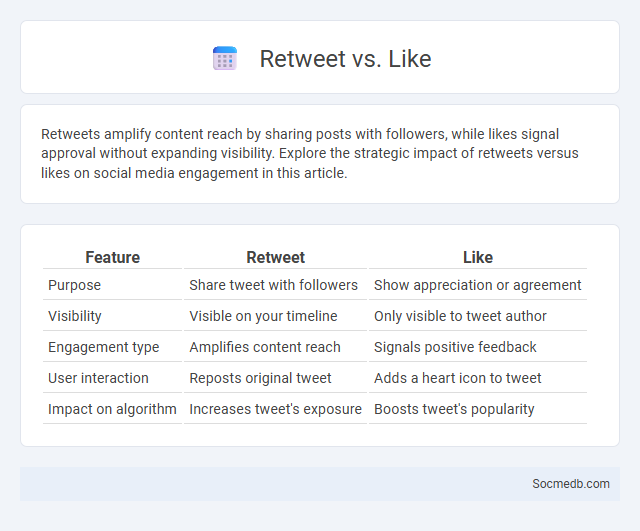
Photo illustration: Retweet vs Like
Retweets amplify content reach by sharing posts with followers, while likes signal approval without expanding visibility. Explore the strategic impact of retweets versus likes on social media engagement in this article.
Table of Comparison
| Feature | Retweet | Like |
|---|---|---|
| Purpose | Share tweet with followers | Show appreciation or agreement |
| Visibility | Visible on your timeline | Only visible to tweet author |
| Engagement type | Amplifies content reach | Signals positive feedback |
| User interaction | Reposts original tweet | Adds a heart icon to tweet |
| Impact on algorithm | Increases tweet's exposure | Boosts tweet's popularity |
Introduction to Twitter Engagement: Retweet vs Like
Twitter engagement metrics, such as retweets and likes, play distinct roles in amplifying content reach and indicating user interest. Retweets enable users to share tweets with their own followers, expanding visibility and driving viral potential, while likes signal approval or agreement without sharing the content further. Understanding the strategic use of retweets versus likes helps optimize social media marketing efforts and enhances audience interaction on Twitter.
What is a Retweet?
A retweet is a social media feature primarily used on Twitter that allows users to share someone else's tweet with their own followers, amplifying the original message's reach and engagement. By retweeting, users can quickly spread news, opinions, or content without creating a new post, while maintaining the original author's credit. This function supports viral content dissemination, community interaction, and real-time information sharing on the platform.
What Does a Like Mean on Twitter?
A like on Twitter represents user approval or interest in a tweet, signaling engagement without requiring a direct response. It helps increase the tweet's visibility through algorithmic promotion, boosting the likelihood of broader reach and interaction. This simple action serves as a key metric for measuring content popularity and audience sentiment on the platform.
Retweet vs Like: Key Differences
Retweets amplify content visibility by sharing tweets with a user's followers, creating broader reach and engagement, while Likes serve as simple endorsements or acknowledgments without promoting redistribution. Retweets impact Twitter's algorithm more significantly, increasing the likelihood of content trending and reaching viral status, whereas Likes primarily contribute to content popularity metrics. Understanding this distinction aids marketers and influencers in strategizing for greater impact and audience interaction on social media platforms.
When Should You Retweet vs Like?
Retweeting amplifies content to your followers, making it ideal when you want to share valuable information or support a cause actively. Liking is a subtler form of engagement, signaling agreement or appreciation without broadcasting the message explicitly. You should retweet when your goal is to increase visibility and interaction, while liking suits moments when you acknowledge content without promoting it extensively.
Impact on Visibility: Retweet vs Like
Retweets significantly amplify content visibility by sharing posts directly to a broader audience, effectively expanding reach beyond the original followers. Likes, while indicating approval, offer limited visibility as they primarily signal engagement without redistributing the content. Metrics show that retweets can increase impressions by up to 150%, highlighting their crucial role in enhancing social media presence.
Audience Perception: Retweet vs Like
Your audience perceives retweets as endorsements that amplify your message to a broader network, signaling strong agreement or interest in your content. Likes, while indicating approval or appreciation, have a subtler impact and do not extend reach beyond immediate followers. Understanding these distinctions helps tailor your social media strategy for maximum influence and engagement.
Analytics: Measuring Retweets and Likes
Analyzing retweets and likes provides critical insights into your social media engagement and audience preferences, helping to refine content strategies and increase reach. Retweets indicate content shareability and community endorsement, while likes reflect immediate audience approval and interest. By leveraging analytics platforms to track these metrics accurately, you can optimize posting times and content types to maximize your social media impact.
Best Practices for Using Retweet and Like
Maximize your social media engagement by strategically using retweets and likes to amplify relevant content and connect with your target audience. Retweet valuable posts with insightful comments to add context and encourage discussions, while liking posts demonstrates appreciation and supports relationship-building. Your thoughtful interactions with retweets and likes enhance visibility and foster a loyal online community.
Conclusion: Maximizing Twitter Engagement
Maximizing Twitter engagement requires consistent posting of relevant content that resonates with target audiences, leveraging trending hashtags to increase visibility and participation. Utilizing Twitter analytics helps identify peak activity times and preferred content types, enabling data-driven strategies for higher interaction rates. Engaging directly with followers through replies, retweets, and polls fosters a sense of community and encourages ongoing user involvement.
 socmedb.com
socmedb.com